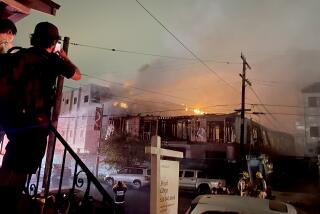The Tragedies--Now the Lawsuits : Baldwin Hills Blaze Blamed on Pepperdine
Thirty-one victims of the arson fire that ravaged the hillside community of Baldwin Hills on July 2 have filed a lawsuit against Pepperdine University, owner of the grass-covered property along La Brea Avenue where the fire was started.
The plaintiffs, residents of 12 of the 66 homes destroyed or damaged in the fire that also left three people dead, filed suit in Superior Court for personal injury and negligence, claiming that the university âso negligently owned, maintained and controlled the . . . property as to cause a flash fire to start.â The suit seeks unspecified damages.
Two Warnings Cited
The attorney for the 31 residents, James H. Davis, said Tuesday at a press conference: âThey allowed Russian grass to grow on that hill despite two warnings from the city and in the process created what is a public nuisance.â
The victims also named the City of Los Angeles as a defendant, Davis said, contending that Fire Department dispatching procedures and water pressure to combat the blaze were inadequate.
Davis said, however, that âthe suit is against Pepperdineâ and that the city was included in the event that âPepperdine may blame the city; for technical reasons I have to have them there.â
Under the cityâs annual weed abatement ordinance, Pepperdine had received notices in early February and mid-June to clear the growth on its 21 acres along La Brea, according to Ed Longley, director of the city Department of Public Works Bureau of Street Maintenance, which supervises compliance.
The ordinance requires clearing the ground 10 feet from the road and 30 feet from structures or wood fencing.
Extension Granted
Pepperdine, Longley added, requested and received an extension âto July 7, so they could use their own forces to do the necessary cleaning.â
A spokesman for Pepperdine University declined comment on the suit.
Among the plaintiffs is Milton Schertle, 78, a 24-year Baldwin Hills resident who was hospitalized along with his wife, Vivian, 64, as a result of the fire. He appeared at the press conference Tuesday, his arms still bandaged because of second-degree burns.
His wife, who suffered second- and third-degree burns when she was knocked down by the force of the fast-moving blaze, is still at Brotman Medical Center, where she has undergone skin graft operations and is listed in stable condition.
A small, frail man, Schertle described himself as âhanging on by my fingernails. But my main concern is for my wife. Sheâs paying a terrible price in pain.â
Geraldine White, another plaintiff, described the four weeks since the fire as âtraumatic.â She said, however, that her reason for participating in the suit is ânot money so much. This may be an example to other companies, the city, that other neighborhoods wonât be destroyed. If the grass had not been there, the fire could not have been set.â
Several plaintiffs were critical of the Fire Department, and two said that when trucks appeared, firefighters either sat in their trucks or uncoiled their hoses so slowly that it was half an hour before they helped fight the fires in their homes. Both homes were destroyed.
Two others said that when they tried to fight the blaze themselves, they had no water pressure.
A spokesman for the city attorneyâs office said the agency had not received a copy of the suit and would withhold comment âuntil the matter is reviewed.â
Response in 6 Minutes
At a Baldwin Hills community meeting a week after the fire, however, Battalion Chief Don Anthony, who had supervised the firefighting effort, told residents that the Fire Departmentâs response time had been six minutes. Within half an hour, 17 companies were on the scene, he said, and he then requested 33 more.
âThe water system was more than adequate,â Anthony said, with a capacity of about 6,000 gallons a minute. With more than 60 structures ablaze, the system was overburdened, he said, with a demand of â10,000 to 12,000 gallons a minute. . . . It is not adequate to fight a fire like that.â
More to Read
Sign up for Essential California
The most important California stories and recommendations in your inbox every morning.
You may occasionally receive promotional content from the Los Angeles Times.










